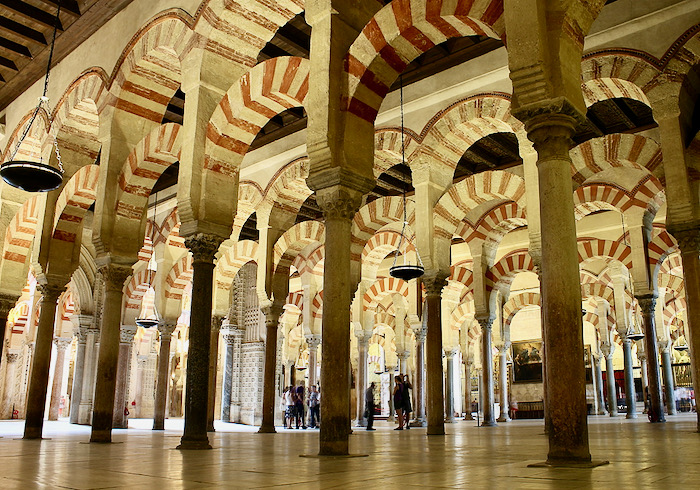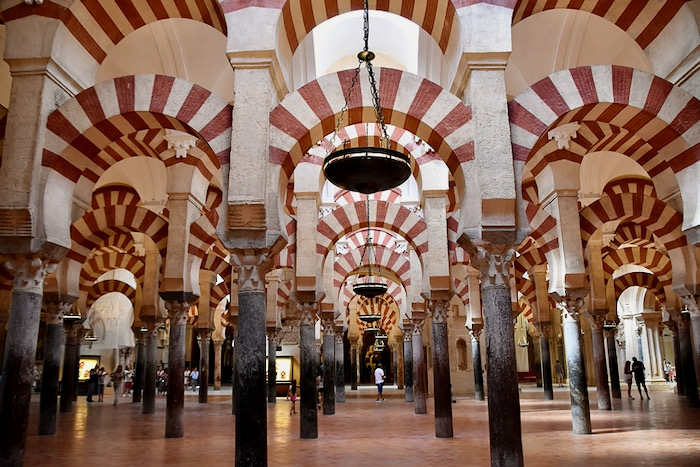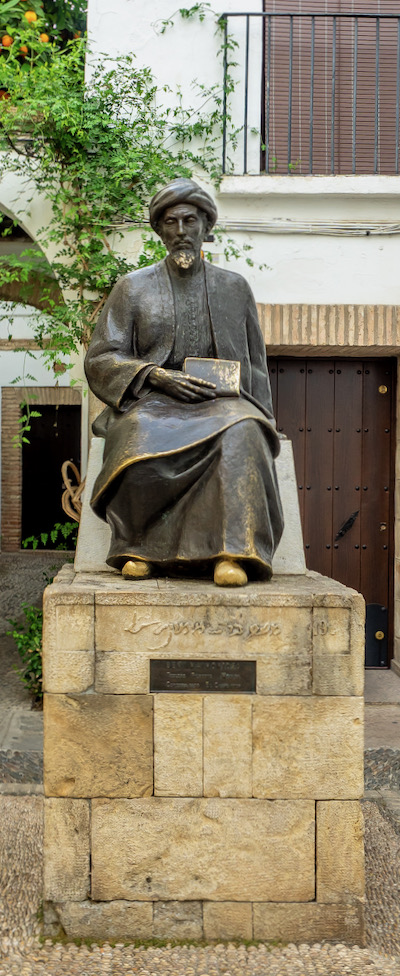
TRULY AWE-INSPIRING FOR MORE THAN 1,000 YEARS. These columns and double-tiered arches, built in the years 785-6, today are among the world’s most-recognized architectural landmarks. Their construction as part of a glorious new mosque was supervised by Abd ar-Rahman, who himself was a refugee from wars in Syria who found a peaceful new life in what is today Spain.
EDITOR’S NOTE: Martin Davis recently returned from Cordoba, Spain, where he took part in the International Association of Religion Journalists conference, “Religion Reporting—the Search for Common Ground among Monotheistic Faiths.” The conference was made possible by generous grants from the Brigham Young University’s International Center for Law and Religion Studies, as well as the Utah Journalism Foundation and the Khosrow Semnani Foundation.
.
By MARTIN DAVIS
Author of 30 Days with America’s High School Coaches
The truest statement of religious faith that I have encountered was found in the movie “Rudy,” about an overachieving underdog who against all odds realizes his dream of playing at Notre Dame Stadium—the cathedral of college football.
“Son, in 35 years of religious study, I’ve come up with only two hard, incontrovertible facts,” says Father Cavanaugh to Rudy as he sits in a church worried that he hasn’t done enough to gain admission to Notre Dame. “There is a God, and, I’m not Him.”
It’s a humbling, awe-inspiring moment that fans of the film remember vividly.

The mosaic-decorated mihrab (center) and the interlacing arches of the maqsura (left and right) are in the extension added by al-Hakam II after 961.
Following nearly a week in Spain, my appreciation for that quote has given way to my own mysterium tremendum et fascinans (a frightening and fascinating mystery, as Rudolf Otto describes the experience of the divine) I felt at the Mezquita de Córdoba.
And it was the words of Córdoba’s most famous son, Moses ben Maimonides, that brought it all together.
That’s a lot to unpack. Let’s begin with the building itself.
The Mezquita de Córdoba—commonly known today as the Mosque-Cathedral—is one of the world’s greatest buildings. Many in the West recognize it instantly from photographs like the ones accompanying this column—even if they can’t name it.
The mosque’s arches and columns, are iconic. To stand in the center of any of the corridors and stare down a row of those columns puts one’s finiteness in perspective with the sense of infinity the corridors create.
In architecture, a building’s vertical space is often used to remind us of the divine. Steeples and minarets and domes all point skyward. But at the Mezquita, it’s these corridors and arches—built on the horizontal plane, that creates the connection with the divine. Whether that was ever the intention is unknowable, but probably wasn’t. The mosque, of course, included a minaret.
For me, however, that experience of the remaining horizontal and vertical planes instilled that sense of the mysterium tremendum Otto described.
Here’s another view to ponder for a moment. My column continues below ...
One’s appreciation deepens when standing upon one of the many black grates that are in the floor of the mosque. Look down beneath your feet, and you’ll see the remains of Roman mosaics that some claim were part of a Roman temple to Janus. Whether correct or not, the mosque clearly was built atop a Roman structure.
It also stands atop the Basilica of San Vicente Mártir, built by the Visigoths in the 6th century AD. There is mystery surrounding this building, too. The latest archaeological evidence of this site beneath the mosque confirms it is indeed from the 6th century, is certainly Visigothic, and certainly Christian, as it shows signs of having been an episcopal seat. Whether it is the Basilica of San Vicente Mátir, however, can’t be established.
The mosque that stands upon these two foundations (and one must wonder if there are still more beneath them) was started in the 8th century, went through several expansions in the Late Antique/Early Medieval period—before it was consecrated as a church in 1236 by the Spanish King Fredinand III.
Still, the work continued, with several chapels built subsequent to the creation of a Renaissance cathedral nave and transept beginning in the 16th century. Though impressive in its own right, this structure appears to some visitors today—myself among them—as more a scar on this grand piece of architecture than an advancement in the building’s character.
Be that as it may, from bottom to top, the history of pagan, Christian, and Muslim heritage is written on this site as geologic time is written on walls of canyons.
I would argue the faith story is still evolving at this site, revealing the influence of agnosticism and secularism. Though often chided as anti-religious, the precise opposite it true of these two modern movements. These traditions recognize the power and beauty and importance of these religious markers, and Córdoba, UNESCO, Spain, and other nonreligious powers have done a remarkable job preserving this treasure.
And this brings us to Maimonides.
Born in Córdoba, in 1135 supposedly, Maimonides remains a great influencer of Jewish thought—and his influence extends far beyond Judaism. His description of philanthropy and its levels of purity, for example, remains a driving force in today’s culture.
More important, it can be argued that Maimonides’ demythologizing of religion laid the groundwork for modern-day spirituality. The increasing belief expressed by many, including this author, that the institutions of religion and the prescribed practices thereof ultimately get in the way of the experience of the divine, may well resonate with the great Jewish thinker.
Per the Stanford Encyclopedia of Philosophy: Maimonides “recognizes that when one is first exposed to Bible stories and the ritual of daily prayer, one may need anthropomorphic descriptions of God and promises of material reward.” The Torah, for example, is delivered in a way that ordinary people can understand it. “If it did not,” the writeup continues, “its appeal would be greatly reduced. But … the purpose of the religion [for Maimonides] is to get one to the point where these things cease to matter and are eventually overcome.”
With that understanding, we can see that for Maimonides, the divine is essence. And anything we do to grasp that moves us further from it.
“Know that when you make an affirmation ascribing another thing to Him, you become more remote from Him in two respects: one of them is that everything You affirm is a perfection only with reference to us, And the other is that He does not possess a thing other than His essence …”
What does this all mean?
For me, an individual who long ago gave up the practice of faith within any religious institution following years of study within those institutions, I came to appreciate that reaching a connection with the divine rests not in trying to name and define something on the vertical plane of existence. That’s a plane that by definition we can’t understand.
Rather, we encounter that essence on the horizontal plane. In moments that defy description and are beyond our ability to explain. Moments when we, ever so briefly, move outside ourselves into a deeper, spiritual realm.
For this writer and journalist, the Mezquite de Córdoba and the teachings of the city’s greatest intellectual native son, were a spiritual revelation.
The mosque-cathedral’s history from bottom to top represents the imperfect attempts by humans to understand and control the way others think about the divine. Not necessarily failed efforts, but rather efforts wrought of humans and their power trying to define the undefinable and force others to accept it. Efforts that begin well-meaning, gain clarity and power, but ultimately fall under the weight of the next movement.
The sense of eternity created by the mosque’s horizontal design, however, creates for all an opportunity to place ourselves in a moment of infinity, and recognize our ultimately limited space in it.
Rather than try and define that experience, we accept it for what it is, on our plane in our time, and move forward.
That is religion at its purist, Mainmonides suggested.
It’s no surprise, therefore, that a trip to his land brought me to the realm of the mysterium facinans.
In the realm of spirituality, sometimes, it’s best just to be fully in where we are, and appreciate those moments whenever so briefly we move outside ourselves.
Finding the divine, it turns out, isn’t all that hard.
It’s all around us. If we just sit still, and be.
.
PHOTOGRAPHS with this column are courtesy of Wikimedia Commons and can be shared with others. You will find most of them featured in the Wikipedia page about the Mosque-Cathedral and the photo of Maimonides on his Wikipedia page.
.
Care to read more?
ARE YOU INTRIGUED by this column from Martin Davis? You will also enjoy his book: 30 Days With America’s High School Coaches.
Martin Davis is a journalist living in Fredericksburg, Virginia, where he is the Opinion Page editor of The Free Lance-Star in his hometown of Fredericksburg, Virginia.





Glad to read of Martin’s “ Mysterium” experience and that it may be found among the ordinaries of daily living or in the horizontal space of the Córdoba mosque. From my experience I took the ever- changing and evolving nature of humans relation to the divine as the layers of architecture direct. The beauty off those striped columns can also be found among some of the Romanesque churches.